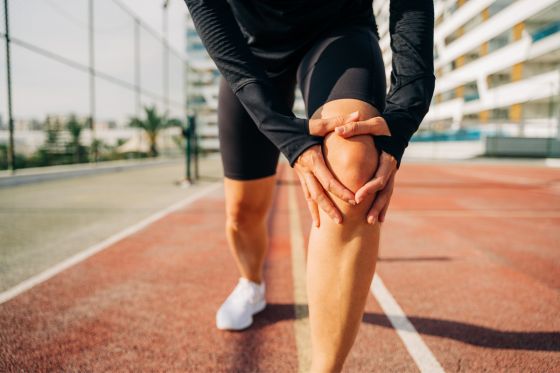If you’re a runner or endurance athlete, you know that knee pain can be a significant barrier to maintaining your training regimen and achieving your fitness goals.
One of the most common ailments that runners face is “runner’s knee,” a term used to describe pain around the kneecap.
This blog will delve into five detailed runner’s knee exercises designed to strengthen your knees and help prevent or ease knee pain and injuries.
By incorporating these exercises into your routine, you can ensure that you keep moving pain-free and stay on track with your training.
Understanding Runner’s Knee
Runner’s knee, or patellofemoral pain syndrome, is a common condition that results from overuse, misalignment, or improper mechanics of the knee joint.
Runners, especially those training for marathons or engaging in long-distance running, are particularly susceptible to this condition.
Common causes include weak or imbalanced muscles, improper running form, and inadequate footwear.
Addressing these issues with targeted exercises can significantly reduce pain and improve knee function.
1. Step-Ups
Step-ups are a simple yet effective exercise that can enhance your athletic performance and everyday functionality.
This movement mimics real-life activities like climbing stairs or hiking, making it highly functional.
Steps:
- Find a sturdy bench or step that is about knee height.
- Stand facing the bench with your feet hip-width apart.
- Place your right foot firmly on the bench.
- Push through your right heel to lift your body onto the bench, bringing your left foot up to meet your right.
- Step down with your right foot first, then your left foot.
- Repeat for 10-15 repetitions on each side.
Benefits:
- Strengthens Lower Body: Step-ups target your quadriceps, hamstrings, and glutes, building powerful legs that can withstand the rigors of running, cycling, or any sport you love.
- Improves Balance and Stability: By working one leg at a time, step-ups enhance your balance and stability, crucial for preventing injuries and improving overall athletic performance.
- Boosts Cardiovascular Health: Performing step-ups at a brisk pace can elevate your heart rate, contributing to better cardiovascular fitness without the need for high-impact activities.
- Enhances Functional Strength: This exercise mimics daily movements, making it easier to perform everyday tasks with ease and reducing the risk of injury.
2. Lunges
Lunges are a versatile and dynamic exercise that can transform your lower body strength and stability.
Perfect for athletes and active individuals, lunges help improve your performance in a variety of sports and activities.
Steps:
- Stand tall with your feet hip-width apart.
- Take a step forward with your right foot, lowering your hips until both knees are bent at about 90 degrees.
- Ensure your right knee is directly above your ankle and your left knee is hovering just above the ground.
- Push through your right heel to return to the starting position.
- Repeat for 10-15 repetitions on each side.
Benefits:
- Builds Leg Strength: Lunges effectively target the quadriceps, hamstrings, and glutes, developing the power needed for running, jumping, and cycling.
- Enhances Core Stability: By engaging your core to maintain balance, lunges help strengthen your abdominal and lower back muscles, crucial for a strong and stable midsection.
- Improves Hip Flexibility: Lunges promote hip flexibility and mobility, essential for preventing injuries and maintaining proper running form.
- Corrects Muscle Imbalances: By working one leg at a time, lunges can help identify and correct muscle imbalances, leading to more efficient and injury-free movement patterns.
3. Squats
Squats are a lower body exercise offering unparalleled benefits for athletes and fitness enthusiasts.
Incorporating them into your routine can significantly enhance your strength, power, and overall athletic performance.
Steps:
- Stand with your feet shoulder-width apart and your toes slightly turned out.
- Lower your body as if you’re sitting back into a chair, keeping your chest up and your knees tracking over your toes.
- Go as low as you can while maintaining good form, ideally until your thighs are parallel to the ground.
- Push through your heels to return to the starting position.
- Repeat for 10-15 repetitions.
Benefits:
- Maximizes Lower Body Strength: Squats engage the quadriceps, hamstrings, glutes, and calves, building a solid foundation of strength essential for any sport or activity.
- Boosts Athletic Performance: By developing explosive power and strength, squats can improve your performance in running, jumping, and other high-intensity activities.
- Enhances Core Stability: Squats require a strong core to maintain proper form, helping to strengthen your abdominal and lower back muscles, reducing the risk of injury.
- Promotes Functional Fitness: Squats mimic everyday movements like sitting and standing, improving your ability to perform daily tasks with ease and reducing the likelihood of injury.
4. Single-Leg Deadlifts
Single-leg deadlifts are a fantastic exercise to enhance balance, stability, and strength.
This exercise is particularly beneficial for runners as it helps strengthen the muscles that support the knee and hip.
Steps:
- Stand with your feet hip-width apart, holding a dumbbell in your right hand.
- Shift your weight onto your left leg and hinge forward at the hips, lifting your right leg straight back behind you.
- Keep your back flat and lower the dumbbell towards the ground.
- Return to the starting position by pushing through your left heel.
- Repeat for 10-15 repetitions on each side.
Benefits:
- Strengthens Posterior Chain: Single-leg deadlifts target the hamstrings, glutes, and lower back, crucial for powerful and efficient running.
- Improves Balance and Coordination: This exercise challenges your balance and coordination, enhancing your overall athletic performance.
- Reduces Injury Risk: Strengthening the muscles around the knee and hip can help prevent injuries by improving stability and support.
- Enhances Core Stability: Single-leg deadlifts engage the core muscles to maintain balance, contributing to a strong and stable midsection.
5. Glute Bridges
Glute bridges are an excellent exercise for strengthening the glutes, hamstrings, and lower back.
This exercise is particularly beneficial for runners as it helps improve hip stability and reduces the risk of knee pain.
Steps:
- Lie on your back with your knees bent and feet flat on the ground, hip-width apart.
- Place your arms by your sides with your palms facing down.
- Push through your heels to lift your hips off the ground, creating a straight line from your shoulders to your knees.
- Squeeze your glutes at the top and hold for a few seconds.
- Lower your hips back to the starting position.
- Repeat for 10-15 repetitions.
Benefits:
- Strengthens Glutes and Hamstrings: Glute bridges effectively target the glutes and hamstrings, crucial for hip stability and knee support.
- Improves Hip Mobility: This exercise promotes hip mobility, essential for maintaining proper running form and preventing injuries.
- Reduces Lower Back Pain: Strengthening the glutes and lower back can help alleviate lower back pain by providing better support and stability.
- Enhances Core Stability: Glute bridges engage the core muscles, contributing to a strong and stable midsection.
Your Next Steps to Injury-Free Sports
Running should be a source of joy, not pain.
By incorporating these runner’s knee exercises into your routine and seeking expert guidance when needed, you can keep on running with confidence.
Remember, staying active and healthy is a journey, and we’re here to support you every step of the way.
As the leading endurance athlete expert in Long Island, I’ve helped thousands of both professional and amateur athletes recover from injuries and implement strategies that would help them avoid injuries in the future.
If you want to find out more about working with me, you can start with a few free options:
Free Advice Report
Download our Free Advice Report for in-depth information and tips on preventing sports injuries. It’s packed with valuable insights tailored for runners like you.
Free Telephone Consultation
Arrange a Free Telephone Consultation – a conversation with our expert team to discuss your running goals and concerns. This consultation is an opportunity to learn how we can support your journey to pain-free running.
Free Discovery Visit
Come visit our clinic in Long Island for a Free Discovery Visit. Explore our facilities, meet our team, and discuss how our treatment programs can help you stay on track, injury-free.
Get in touch today and let’s keep you running strong, healthy, and happy!
More Free Advice For Endurance Athletes
If you want to stay up to date with the latest advice on injury prevention and treatments, you can follow us on social media and read our expert articles.
Follow us on Facebook and Instagram for more free tips and updates from our Long Island physical therapy clinic.
You can also watch our YouTube videos for more expert advice.
Make sure you Avoid These Common Running Injuries To Stay On Track, On The Track!
Find out what The Best Sports Injury Prevention Tactics That Will Keep You In Game are.




